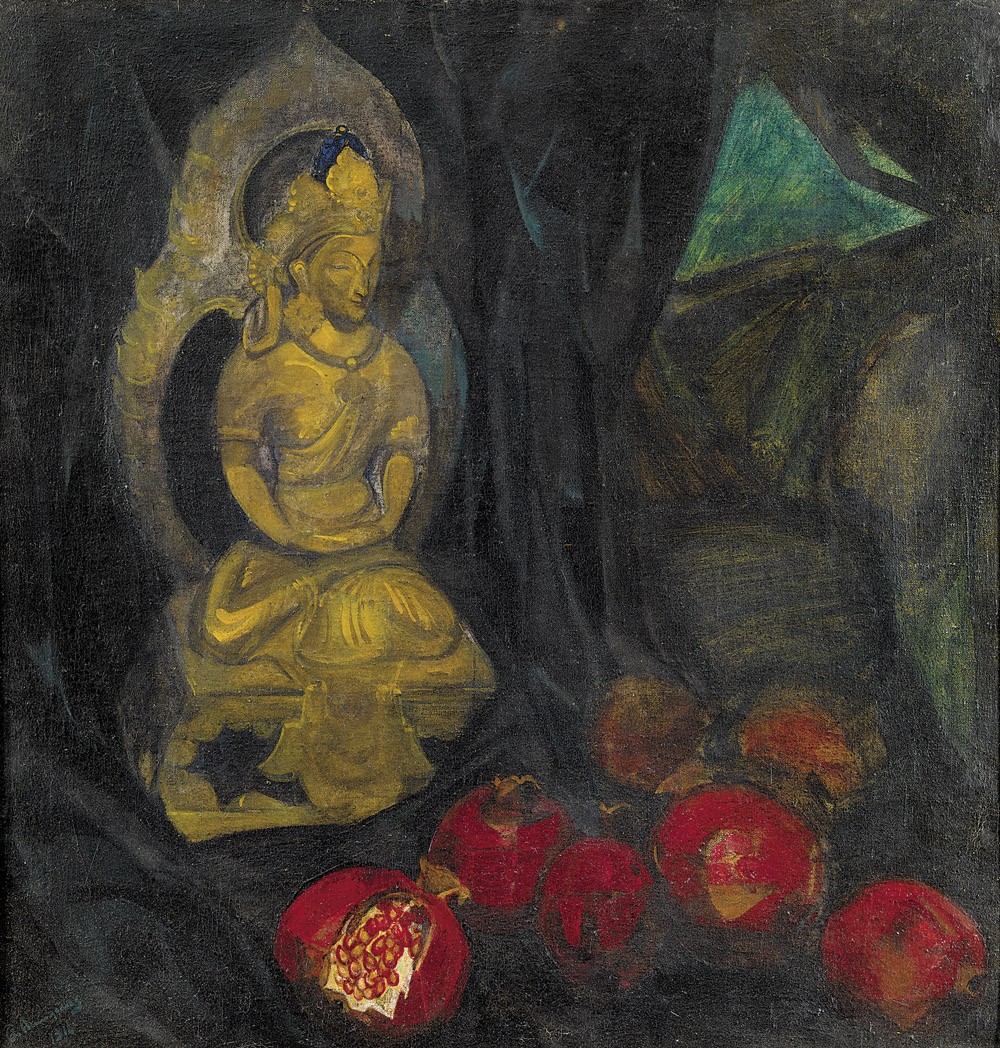MacDougall Auctions 28 November 2008
28 November 2008

* 16. ANISFELD, BORIS 1879-1973
Buddha with Pomegranates signed and dated 1916
Oil on canvas, 70.5 by 68 cm.
100,000-150,000
Provenance: Acquired directly from the artist's family by the present owner.
Private collection, USA.
Exhibited: Mir Iskusstva, Petrograd, 1916.
Boris Anisfeld Exhibition (Touring), The Brooklyn Museum, New York, USA, 1918-1920, No. 61.
Duke University Museum of Art, Durham, NC, 2001-2006.
Boris Anisfeld: Watercolours, Oils and Sculptures, MacDougall's, London, 22 September-31 October 2008.
Literature: Exhibition catalogue, C. Brinton, The Boris Anisfeld Exhibition, New York, USA, No. 61 illustrated.
Imbued with symbolism, Buddha with Pomegranates was executed
during Anisfeld’s final year in Russia and ranks as one of his most
outstanding works. This effective and decorative work exemplifies
the fascination with Buddhism and the east in general which permeated
Russian art in the early 20th century, and it was during
this period, that a number of Buddhist references appeared in
Anisfeld’s works. They were not consciously inserted by the artist
but, rather, absorbed by him as part of the ethos of symbolism
and the general atmosphere of interest in theosophy and esoterica.
In all probability, Anisfeld was already familiar with basic Buddhist
principles, which were widely disseminated at this time – and those
such as the correct interpretation of the concept of emptiness, or
the problem of the relationship between man and the cosmos,
were close to the Russian heart.
The composition of the still life as a whole is constructed utilising
Buddhist symbolism. The seven pomegranates which are lying
in front of a statue of Buddha not only represent (along
with citrus and peach) blessed fruits, but are also a symbol of
the “seven treasures”, seven sacrifices or seven attributes of a
monarch i.e. symbols of everything which was renounced by
Siddhartha Gautama when he became Buddha (and these included:
“the wheel of law” with 1000 spokes, which was a symbol
of symmetry and perfection; the precious stone which grants
every wish; the true and devoted wife who is concerned for her
husband; the clever minister on whom law and order in a state
depends; a white elephant, a symbol of sovereignty of an eastern
ruler; the horse, a symbol of the chariot of the sun; a general
who has vanquished all his enemies).
The green triangle as an image also has profound metaphysical
overtones. This is an element which the “esoteric” artists who
were contemporaries of Anisfeld treated as a “symbol of the
world in every religion, system and even in heretical schools of
thought, from prehistoric times to the present day”.
The very composition of this work, in which pomegranates are
scattered before a statue of Buddha as if they are some sort of
offering, brings to mind the following Buddhist parable: A great
king, who wanted to earn the Buddha’s approval, was listening
to a sermon by the Buddha on the subject of self denial and inner
peace. The Buddha always carried a drum with him:
“Teacher, why do you have a drum?” asked the king. The
Buddha replied: “I will beat it on the day of the greatest sacrifice
made to me”. Everyone of course wanted to know who
would make this sacrifice.
The king, hearing Buddha speak these words, loaded heaps of
treasure onto his elephants and sent them off to Buddha. He
wanted to sacrifice these riches to Buddha and earn his blessing.
On the way the king met an old woman who curtseyed and
said: “I am very hungry, won’t you give me something to eat?”.
The king took a single pomegranate out of the basket and
handed it to her. The old woman went to Buddha bearing this
piece of fruit. At the same time the king, expecting to hear the
drum beat, arrived at the Buddha’s ashram, and led his treasure
laden elephants to the Buddha.
However, the old woman, scarcely able to walk, approached the
Buddha and placed the pomegranate at his feet. Buddha accepted
it, and there and then beat the drum. The king was shaken, and
asked the Buddha: “Swami, I have made a sacrifice to you of so
much treasure, yet your drum remained silent, but now you have
beaten it when offered merely a single piece of fruit. That is
hardly a sacrifice, is it?” The Buddha replied: “Oh king! A sacrifice
is not measured in quantity. Quality is what is important, you
are a king and naturally you give gifts of gold, But this old
woman, although she is very hungry, has not eaten her pomegranate
but instead has offered it to me, even though it could
have eased her hunger. Can a greater sacrifice be imagined?”
Such a metaphorical understanding of images is characteristic of
all Anisfeld’s creative oeuvre. It was shaped not so much by the
influence, in his early years, of the artists of the “World Art” association
with whom he had been taking part in exhibitions
since 1911, as by his proximity (both in terms of painting technique
and in terms of subjects) to the work of certain masters
of the “Blue Rose”. The multiple and nuanced paint combinations,
unrealistic colours and virtuoso brushwork place Buddha
with Pomegranates in the same class as the works of Roerich,
Golovin and Grigoriev, which helped to bring about a renaissance
of eastern spiritual practices in early 20th century art.
Notes on symbols:
* Indicates 5% Import Duty Charge applies.
Ω Indicates 20% Import Duty Charge applies.
§ Indicates Artist's Resale Right applies.
† Indicates Standard VAT scheme applies, and the rate of 20% VAT will be charged on both hammer price and premium.